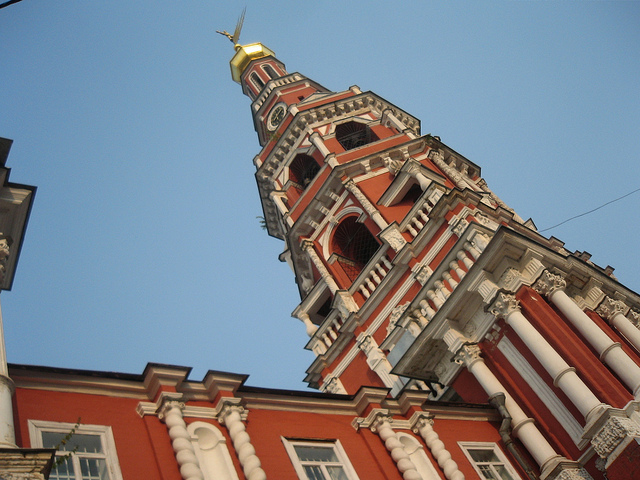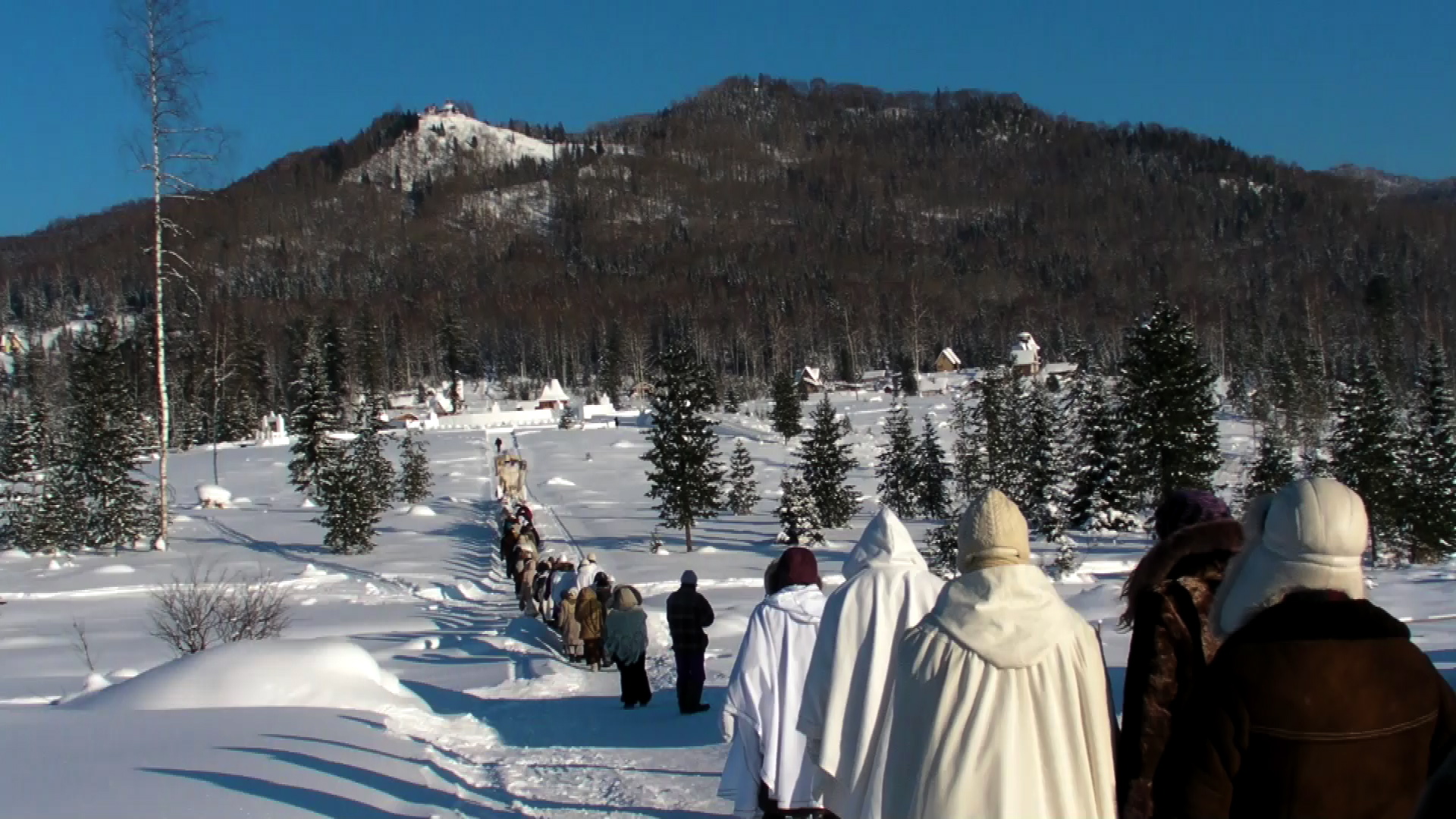
In the early 1980s, a reporter for Pravda based in the city then known as Gorky learned of a new general plan from the Soviet government for his hometown. The plan was to abolish the entire historical center of the picturesque city, which was founded in the 13th century at the point where the Volga and Oka rivers cross. In place of the old city's gracefully carved wooden and stone mansions, Soviet architects proposed the construction of monstrous concrete housing blocks. Remarkably, the critical article the reporter wrote describing the historical and cultural importance of the city's architecture slipped past the grabby hands of the paper's censors and came out in print.
Shortly afterward, a commission of important bureaucrats arrived from Moscow and invited the Pravda reporter to an official meeting at the local Kremlin, as the fortified castles at the center of most Russian cities are known. "What part of the city would you like to preserve?" one official asked in a dry tone, pointing at the city's map on his table. The reporter rose on his tiptoes and then lay down across the map, trying to cover most of his favorite historical streets, the ones with delicate, ornamented houses, with his body. The master plan was eventually canceled and for a few more decades Gorky, which in the Perestroika years was given back its original name, Nizhny Novgorod, continued to charm its inhabitants.
Rare in Soviet times, that sort of victory of culture and history over business and development is nearly unheard of today. The reporter was my father. He now works for a local state television company producing documentaries. His programs urge authorities to put an end to daily destruction of the old town, which played a key role in Russian history as the site where a volunteer movement began that once saved Moscow from Polish invaders in 1611.
Sadly, his efforts have been in vain. Small pockets of the original city, where every door and every window display a fading but original beauty, are being squeezed out by an explosion of cheap construction. No newspaper articles, television shows, human barricades -- or even living people refusing to leave their condemned old homes -- are able to stop the bulldozers as they bring down entire blocks of the 790-year-old city. To force people out of their homes, the state turns off their gas and electricity; the police detain those who refuse to move. Mysterious fires often break out, clearing lots slated for demolition.
Earlier this year, 12 houses that happened to stand on the way of an expanding metro line heard their final verdict. The deputy head of the city administration, Sergey Gladyshev, declared the need to "clean the space" for a new construction project consisting of a metro center, a shopping center, and new office and residential buildings. It was deemed much more important to have subway access than to preserve the original face of one of Russia's oldest towns, with its irreplaceable Russian wooden architecture. The decision was announced after the regional authorities, without much explanation, removed another 76 wooden buildings from the official historical protection register. It was as if the famed Victorian sections of San Francisco were condemned simply for being made of wood.
Nizhny Novgorod's old city is known as one of the world's best examples of Russian Byzantine design, a distinctive style of brick and wood buildings popular in the 1830s. Why would authorities allow the country's history to vanish without a trace? Nizhny Novgorod's citizens know the answer: The kickbacks city planners receive from the construction of malls, subway bridges and highways is a major motivation, while the restoration of crumbling, 18th-century wooden buildings with round towers, thick verandas and multiple layers of carved ornaments, is no way for an enterprising local official to line his pockets.
The chair of the local branch of Russia's public committee for the preservation of monuments, Yuriy Filipov, doubts that anything could stop the bulldozers this time, saying, "I would never go to street protests to defend old buildings."
"Once I made an attempt, but my boss at work warned me about potential problems that could cause. We live in a police state, going back to 1937," he says, referring to the start of Stalin's great purges.
The majority felt the same way, for a long time, but that may be changing. It has taken nearly two years of constant bulldozer attacks to wake up some awareness in my hometown, a city of 1.2 million people. During a recent visit, I watched pedestrians, some indifferent, others too pessimistic about any significance of their voice in the city life, hurried past ruined blocks of once proudly sophisticated 17th- and 18th-century homes. Sad graffiti of crying faces, sketches of skeletons, and emotional outcries like "We are not rats!" appear on the walls of abandoned houses.
Adjacent to the old city, the part of town built during the Soviet period reminds tourists of the years when the academic Andrei Sakharov was exiled here, when Gorky was the site of secret military-industrial production and closed to foreign visitors. It is a sprawl of apartment blocks, comfortable enough but without character. Young lovers traditionally preferred to date in the cafes around the Kremlin, or wonder the hilly, narrow streets of the old city and admire the view over the broad Volga and Oka rivers washing the forested banks on the opposite side. Soon, this postcard card view will be taken from them, too: In their infinite wisdom, Nizhny's city planners have decided to place an enormous concrete mouth, a hulking soccer stadium right on the Strelka Peninsula -- the point where the two rivers meet.
The tipping point for Nizhny Novgorod's civil society came last June, when locals saved a severely injured man from a burning house on the corner of Pokrovka and Arzamasskaya streets. Eager to free space for a modern glass and concrete skyscraper, someone may have set the old abandoned house on fire without checking if any living people were inside.
The small uprising that resulted began from within a group on Russia's biggest social network, Vkontakte.ru, called "Alive in Nizhny Novgorod." Within days, 95 people upset about authorities stripping their city of all its beauty had joined the group and worked out a strategy to either barricade the doors and stay inside their condemned houses or form a living fence to prevent the bulldozers from approaching their favorite buildings. Earlier this month, 20 activists gathered to block a bulldozer on its way to demolish a two-story 19th century merchant's mansion with a beautifully ornamented façade on Gorkogo Avenue. Several dozen police officers quickly arrived and arrested the group's leaders. Three of them were sentenced to 15 days in jail. Within a few hours, the house was demolished.
"This is a war! Our city does not belong to the people but to a group of corrupt, money-thirsty businessmen, who have no idea that they are demolishing historical monuments of great importance and beauty," one of the arrested activists, Alyona Ksenofontova, told me. She promised to gather a movement of at least 2,000 activists. "That would definitely stop the destruction."
Senior officials express doubts. "I have never analyzed the reason for the lack of public activity in Nizhny Novgorod, but my prediction is that there will never be more than 100 people coming to stop the bulldozers," local minister of social politics Olga Noskova assured me.
However the showdown between the activists and the city authorities turns out, most of the damage is already done, with only tiny slivers of the city's once proud heritage left standing. It's almost enough to make one nostalgic for the Soviet days, when one newspaper article was enough to shame authorities into halting their plans.



